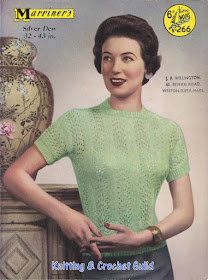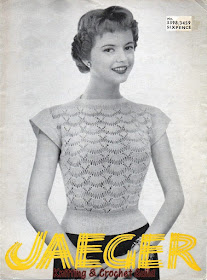Two friends who visited recently, and know I like old magazines, brought me a
Woman and Home magazine from 1942 - a very welcome gift. The cover is very worn and coming apart down the spine, but the contents are in much better condition, and a fascinating glimpse of war-time conditions.
Woman and Home was, and still is, a monthly magazine. It was launched in 1926, and had incorporated
Good Needlework magazine from 1940 or 1941.
The cover shows three things that you could make from instructions inside. There is one knitting pattern, for a high-necked ribbed cardigan (also described as a 'button-up jumper') that you could wear on its own or over a blouse.
Inside, there is an illustration of the tiny V-shaped pocket, which "will hold a small handkerchief to match the blouse". (Only for show and not for use, I hope.)
Clothes rationing had been in force for over a year by that stage of the war, so a cardigan was a useful garment, especially if you could wear it buttoned up and treat it as a jumper. There is also advice in the magazine on unravelling old knitted garments to re-knit the wool into something else. And all oddments of wool could be carefully saved - the magazine gave instructions for crocheting collars and necklets, including the African-inspired one shown on the cover, out of rug wool (not rationed, I believe) and brightly-coloured oddments of knitting wool. There are dress-making features, too - again covering making old garments into new.
It seems that paper for non-essential uses was getting scarcer (although magazines like
Woman and Home had not yet been much reduced from their pre-war size) and shops were not providing paper bags for purchases. (This of course pre-dates by a long way the current concerns over single-use plastic packaging - many things like fruit and veg were sold loose, and only wrapped up in paper or put into a paper bag when you bought them.) So to deal with this you could make a shopping bag with a wipeable lining to hold everything.
As well as the needlework features, there is quite a lot of fiction - two serials and a complete story. One of the serials is by Pearl S. Buck, an American novelist who had been awarded the Nobel Prize for Literature in 1938. The magazine doesn't mention that, though it does say that she wrote
The Good Earth, a novel set in China which is her best known book. The
Woman and Home serial is called
Answer to Life!, listed as a 1941 novella in a
list of her works. Its main character is a young woman who wants to train as a surgeon, a very difficult thing in those days. Her mother is a doctor, and apparently the main bread-winner for the family, as her husband has been damaged mentally in some unspecified way by his experience in the previous war. There are two young men who also appear in the first episode - I imagined that in future episodes the young woman would fall for the wrong one and then eventually realise that the other is a better choice. But I was completely wrong - after some digging around, I found an article about the novella
here. She does marry the wrong man, and the marriage breaks down, and having given up her training to marry and have children, she goes back to her ambition to be a surgeon. Not the usual women's magazine romance at all.
I'm fascinated by the ads in the magazine, too. There are a few that advertise knitting wools, and two of those feature pattern leaflets - like the pattern in the magazine, they are for high-necked cardigans.
Both the Golden Eagle and Femina ads stress 'coupon economy' - I think this refers to the fact that your clothing coupons went further if you knitted your clothes instead of buying them ready-made. But apart from rationing, knitting wool was hard to find even if you had the coupons to spare, as the Femina ad says: "Intensified war production means a shortage of many things, including Femina w
ools — but they are always worth waiting for."
The Copley's ad goes even further in acknowledging that wool was scarce: it has one of a series of "Couplets of Knitwise Notions",
Cut out the front, crop waist and sleeves, of winter-time's thick sweater;
bind firmly — this bolero makes your best frock even better.
(Though I can't help thinking that you would be sorry next winter when you didn't have your thick sweater any more.)
But it does go on to say that you might be lucky and be able to buy some new Copley's wool: "You're a good knitter (and a good sort) if you put Comforts first, put brains into "remakes," and put wrapping paper in your shopping bag — ready for some "Excelsior" or some other Copley line and a Copley leaflet when your woolshop has a supply."
There are ads for some products that are still around - Weetabix, Bovril, Knight's Castile soap. And Ryvita, which surprised me - I thought it was a much later import from Sweden.
But as I discovered
here, it was imported from Sweden long before the war (from 1925) and was made in Britain from 1936.
There were a couple of public information notices, too, one from the Ministry of Food, encouraging women to collect wild produce from the countryside - elderberries, crab apples, rowan berries, rose hips, haws, mushrooms and blackberries. I was a bit surprised that the section on mushrooms does not give any advice on identifying safe fungi, or warn that some fungi are deadly. Perhaps people were more aware in those days - but then you'd think that they wouldn't need the ad in the first place.
So the magazine had plenty of valuable content for 9d. A good read, and useful things to make.

















